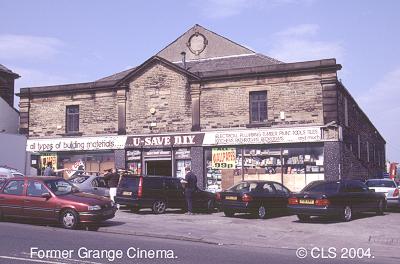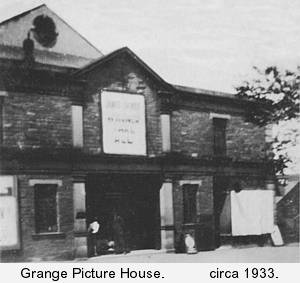|
Grange Picture Theatre / The Grange Great Horton Road, Bradford.  Quick links to other sections on this page . . .
Location The Building Auditorium Hector J. Hill clearly recalls . . . "In addition to the two logitudinal aisles, there was a cross-over aisle which ran between side exits. The latter opened straight to the outside and were sources of stray daylight, outside noise and draughts. The cross-over aisle separated the cheapest seats (no armrests and an incomplete (half) backrest from the middle-priced ones. The dearest seats were a continuation at the rear of the middle block. Two heavy ornamental ropes with metal fittings and hooks were hung between the rearmost cheapest seats either side of the longitudinal aisles. Also the cheapest seats were accessed down the right-hand side of the building (there was a covered canopy) through an entrance at the very end of the side wall. There was a tiny pay box opening in the wall, after which one took a few steps, turned to the right and entered through the double doors onto the cross-aisle below the screen. One emerged from a box-like construction of panelled wood that was built in the lower right corner of the auditorium." Proprietors Grand Opening "The cinema which will be auspiciously opened this evening, accommodates 1,100 persons, and is appointed on thoroughly up-to-date lines." The Grange Picture Theatre opened on Saturday 23rd December 1922 with . . . Grand Opening PerformanceThe opening film was a one-off performance of . . . D.W. Griffith's Drama MasterpieceThen from Wednesday 27th December 1922 the public were able to see . . . "Smilin' Through" - 1922 USA B/W SilentThe Chief Projectionist was Cyril Thornton. The Bradford Daily Telegraph reported on 26th December 1922 . . . "There was an auspicious opening at the Grange Cinema, Great Horton Road, and congratulating speeches were delivered by the City Council representatives for the Ward. The cosy character of the hall with its rich red plush seating and tip-up chairs was freely commented upon." Musical Attractions Week commencing Monday 1st October 1923A later conductor of the Grange Orchestra was a Mr Woodhead. E.G. Wilson's nephew, Issac Wilson, became manager of the cinema. Sound Era The Grange Picture House Ltd also took a lease for a short while of Percy Richardson's Cross Lane/Plaza and Elysian cinemas around the time that sound was being installed. By the mid-1930's the seating capacity had been reduced to 1,088 and with prices of 6d to 1/-d for its continuous evening performances with two programme changes weekly. Matinées were now on Wednesday and Saturday afternoon. The nearest competition was a short drive away at the Cross Lane/Plaza or the Elysian in Lidget Green or Empress in Listerhills. From 1940 the new Arcadian super-cinema at Lidget Green was to offer serious competition to all these local picture houses. After the war the prices had risen to 10d to 1/6d then to 1/-d to 1/6d by 1951. Around 1951 the Western Electric sound set had been installed to replace the ageing BTH set. CinemaScope Hector J. Hill observed . . . "CinemaScope at the Grange was a disappointment. The new screen was a rather square construction without moveable masking and with a curtain pelmet, from which the curtains hung in space. There was no (proscenium opening) stage floor or footlights and no enclosure at the sides. They just looked like huge window curtains with a pelmet. CinemaScope was a letter box image on the screen, so the normal aspect ratio image was larger as it filled the screen."A former chief projectionist, W.H. Hopwood, recalls the Kalee No 8 projectors and BTH rectifier and its local service engineer Jack Martin. Closure "The Miracle" - 1959 USA Technicolor 121mins. Later Uses of Building In more recent years, since about 1985, the building has been owned by Adrian Flint and trading as U-Save DIY centre and is still operating in 2010. May not be copied or reproduced without permission.
|
 On the western side of the busy Great Horton Road, a mile from the City centre and just above the junction with Horton Grange Road. The cinema building backed on to Ivanhoe Road. The surrounding district was (and still is) fairly densely populated with streets of terraced housing.
On the western side of the busy Great Horton Road, a mile from the City centre and just above the junction with Horton Grange Road. The cinema building backed on to Ivanhoe Road. The surrounding district was (and still is) fairly densely populated with streets of terraced housing.